Attachment Style, Task Difficulty, and Feedback Type: Effects on Cognitive Load
Abstract
1. Introduction
1.1. Attachment Styles and Cognitive Resource Allocation
1.2. Feedback, Emotional Regulation, and Inhibitory Control
1.3. Objectives of the Current Study
1.3.1. Theoretical Background and Rationale
1.3.2. Cognitive Load and Feedback Processing
1.3.3. Methodological Approach and Novel Contribution
1.3.4. Limitations and Hypothesis Development
2. Materials and Methods
2.1. Description of the Dot Counting Task
2.2. Study Population and Initial Assessment
2.3. Sample Selection
2.4. Experimental Procedure and EEG Recording
3. Data Processing, Results, and Analysis
3.1. Data Processing
3.2. Attachment Style and Feedback Effects on Cognitive Load
3.2.1. Statistical Results
3.2.2. Interaction Between Attachment Class and Group Feedback
3.2.3. Interaction Between Attachment Class and Personal Feedback
3.3. Post Hoc Comparisons for Specific Feedback Conditions
3.3.1. Personal Feedback: Positive vs. Negative Feedback
3.3.2. Personal Feedback: Negative Feedback
3.3.3. Personal Feedback: Positive Feedback
3.3.4. Group Feedback: Positive vs. Negative Feedback
3.3.5. Group Feedback: Negative Feedback
3.3.6. Group Feedback: Positive Feedback
3.3.7. Summary of Post Hoc Comparisons
3.4. The Effect of Task Difficulty, Attachment Style, and Feedback on Cognitive Load
4. Conclusions and Future Work
4.1. Feedback and Cognitive Load in Relation to Attachment
4.2. Task Difficulty and Cognitive Load
4.3. Implications for Emotional Regulation and Feedback
4.4. Implications for Adaptive Systems and Feedback Design
4.5. Limitations and Future Directions
Author Contributions
Funding
Institutional Review Board Statement
Informed Consent Statement
Data Availability Statement
Conflicts of Interest
References
- Ahmad, M. I., Robb, D. A., Keller, I., & Lohan, K. (2020). Towards a multimodal measure for physiological behaviours to estimate cognitive load. In Engineering psychology and cognitive ergonomics. Mental workload, human physiology, and human energy (pp. 3–13). Springer. [Google Scholar]
- Ahmadi, N. K., Ozgur, S. F., & Kiziltan, E. (2024). Evaluating the effects of different cognitive tasks on autonomic nervous system responses: Implementation of a high–precision, low–cost complementary method. Brain and Behavior, 10, e70089. [Google Scholar]
- Angelidis, A., Hagenaars, M., van Son, D., van der Does, W., & Putman, P. (2018). Do not look away! Spontaneous frontal EEG theta/beta ratio as a marker for cognitive control over attention to mild and high threat. Biological Psychology, 135, 8–17. [Google Scholar] [PubMed]
- Angelidis, A., van der Does, W., Schakel, L., & Putman, P. (2016). Frontal EEG theta/beta ratio as an electrophysiological marker for attentional control and its test-retest reliability. Biological Psychology, 121, 49–52. [Google Scholar] [PubMed]
- Archer-Kath, J., Johnson, D. W., & Johnson, R. T. (1994). Individual versus group feedback in cooperative groups. Journal of Social Psychology, 134(5), 681–694. [Google Scholar] [CrossRef]
- Bar-Haim, Y., Lamy, D., Pergamin, L., Bakermans-Kranenburg, M. J., & van IJzendoorn, M. H. (2007). Threat-related attentional bias in anxious and nonanxious individuals: A meta-analytic study. Psychological Bulletin, 133(1), 1. [Google Scholar]
- Basten, U., Stelzel, C., & Fiebach, C. J. (2011). Trait anxiety modulates the neural efficiency of inhibitory control. Journal of Cognitive Neuroscience, 23(10), 3132–3145. [Google Scholar] [CrossRef]
- Becoña, E., & Vázquez, F. L. (2001). Effectiveness of personalized written feedback through a mail intervention for smoking cessation: A randomized-controlled trial in Spanish smokers. Journal of Consulting and Clinical Psychology, 69(1), 33. [Google Scholar]
- Bendezú, J. J., Loughlin-Presnal, J. E., & Wadsworth, M. E. (2019). Attachment security moderates effects of uncontrollable stress on preadolescent hypothalamic–pituitary–adrenal axis responses: Evidence of regulatory fit. Psychological Science, 7(6), 1355–1371. [Google Scholar]
- Bernecker, S. L., Levy, K. N., & Ellison, W. D. (2014). A meta-analysis of the relation between patient adult attachment style and the working alliance. Psychotherapy Research, 24(1), 12–24. [Google Scholar]
- Bowlby, J. (1969). Attachment and loss v. 3 (Vol. 1). Basic Books. [Google Scholar]
- Boyle, S. C., Earle, A. M., LaBrie, J. W., & Smith, D. J. (2017). PNF 2.0? Initial evidence that gamification can increase the efficacy of brief, web-based personalized normative feedback alcohol interventions. Addictive Behaviors, 67, 8–17. [Google Scholar]
- Brown, D., Rodgers, Y. H., & Kapadia, K. (2008). Multicultural considerations for the application of attachment theory. American Journal of Psychotherapy, 62(4), 353–363. [Google Scholar] [CrossRef] [PubMed]
- Buchheim, A., George, C., Gündel, H., & Viviani, R. (2017). Neuroscience of human attachment. Frontiers in Human Neuroscience, 11(136). [Google Scholar] [CrossRef] [PubMed][Green Version]
- Carnelley, K. B., Israel, S., & Brennan, K. A. (2007). The role of attachment in influencing reactions to manipulated feedback from romantic partners. European Journal of Social Psychology, 37(5), 968–986. [Google Scholar] [CrossRef]
- Chang, C. (2019). Ambivalent Facebook users: Anxious attachment style and goal cognition. Journal of Social and Personal Relationships, 36(8), 2528–2548. [Google Scholar] [CrossRef]
- Chen, Y., & Deng, X. (2024). How socially avoidant emerging adults process social feedback during human-to-human interaction after social rejection: An event-related potential study. Behavioral Sciences, 14(6), 457. [Google Scholar] [CrossRef]
- Comte, A., Szymanskaa, M., Monnin, J., Moulina, T., Nezelofa, S., Magnin, E., Jardrie, R., & Vulliez-Coadya, L. (2024). Neural correlates of distress and comfort in individuals with avoidant, anxious and secure attachment style: An fMRI study. Attachment & Human Development, 26(5), 423–455. [Google Scholar]
- Crost, N. W., Pauls, C. A., & Wacker, J. (2008). Defensiveness and anxiety predict frontal EEG asymmetry only in specific situational contexts. Biological Psychology, 78(1), 43–52. [Google Scholar] [CrossRef]
- Cushing, T., Robertson, S., Mannes, J., Marshall, N., Carey, M. J., Duschinsky, R., & Meiser-Stedman, R. (2024). The relationship between attachment and posttraumatic stress in children and adolescents: A meta-analytic review. Development and Psychopathology, 36(3), 1055–1069. [Google Scholar] [CrossRef]
- Czekalla, N., Stierand, J., Stolz, D. S., Mayer, A. V., Voges, J. F., Rademacher, L., Paulus, F. M., Krach, S., & Müller-Pinzler, L. (2021). Self-beneficial belief updating as a coping mechanism for stress-induced negative affect. Scientific Reports, 11(1), 17096. [Google Scholar] [CrossRef]
- Dan, O., Zreik, G., & Raz, S. (2020). The relationship between individuals with fearful-avoidant adult attachment orientation and early neural responses to emotional content: An event-related potentials (ERPs) study. Neuropsychology, 34(2), 155. [Google Scholar] [CrossRef]
- David, M. E., Carter, K., & Alvarez, C. (2020). An assessment of attachment style measures in marketing. European Journal of Marketing, 54(12), 3015–3049. [Google Scholar]
- De Filippi, E., Wolter, M., Pastor de Melo, B. R., Tierra-Criollo, C. J., Bortolini, T., Deco, G., & Moll, J. (2021). Classification of complex emotions using EEG and virtual environment: Proof of concept and therapeutic implication. Frontiers in Human Neuroscience, 15, 711279. [Google Scholar]
- Delorme, A., & Makeig, S. (2004). EEGLAB: An open source toolbox for analysis of single-trial EEG dynamics including independent component analysis. Journal of Neuroscience Methods, 134(1), 9–21. [Google Scholar] [PubMed]
- D’Urso, S., Luongo, R., & Sciarrone, F. (2024, July 22–26). Enhancing educational outcomes through eeg-based cognitive indices and supervised machine learning: A methodological framework. 2024 28th International Conference Information Visualisation (IV) (pp. 1–6), Coimbra, Portugal. [Google Scholar]
- Dykas, M. J., & Cassidy, J. (2011). Attachment and the processing of social information across the life span: Theory and evidence. Psychological Bulletin, 137(1), 19. [Google Scholar]
- Edelstein, R. S. (2006). Attachment and emotional memory: Investigating the source and extent of avoidant memory impairments. Emotion, 6(2), 340. [Google Scholar] [PubMed]
- Edelstein, R. S., & Gillath, O. (2008). Avoiding interference: Adult attachment and emotional processing biases. Personality and Social Psychology Bulletin, 34(2), 171–181. [Google Scholar] [CrossRef]
- Ein-Dor, T., Mikulincer, M., & Shaver, P. R. (2011). Attachment insecurities and the processing of threat-related information: Studying the schemas involved in insecure people’s coping strategies. Journal of Personality and Social Psychology, 101(1), 78. [Google Scholar]
- El Kerdawy, M., El Halaby, M., Hassan, A., Maher, M., Fayed, H., Shawky, D., & Badawi, A. (2020). The automatic detection of cognition using eeg and facial expressions. Sensors, 20(12), 3516. [Google Scholar] [CrossRef]
- Evraire, L. E., Ludmer, J. A., & Dozois, D. J. (2014). The influence of priming attachment styles on excessive reassurance seeking and negative feedback seeking in depression. Journal of Social and Clinical Psychology, 33(4), 295–318. [Google Scholar]
- Gentzler, A. L., Kerns, K. A., & Keener, E. (2010). Emotional reactions and regulatory responses to negative and positive events: Associations with attachment and gender. Motivation and Emotion, 34, 78–92. [Google Scholar] [CrossRef]
- Gillath, O., Bunge, S. A., Shaver, P. R., Wendelken, C., & Mikulincer, M. (2005). Attachment-style differences in the ability to suppress negative thoughts: Exploring the neural correlates. Neuroimage, 28(4), 835–847. [Google Scholar] [PubMed]
- Gillath, O., Giesbrecht, B., & Shaver, P. R. (2009). Attachment, attention, and cognitive control: Attachment style and performance on general attention tasks. Journal of Experimental Social Psychology, 45(4), 647–654. [Google Scholar]
- Gokay, R., Masazade, E., Aydin, C., & Barkana, D. E. (2015, September 14–16). Emotional state and cognitive load analysis using features from BVP and SC sensors. 2015 IEEE International Conference on Multisensor Fusion and Integration for Intelligent Systems (MFI) (pp. 178–183), San Diego, CA, USA. [Google Scholar]
- Heitz, R. P. (2014). The speed-accuracy tradeoff: History, physiology, methodology, and behavior. Frontiers in Neuroscience, 8, 150. [Google Scholar]
- Hepper, E. G., & Carnelley, K. B. (2012). The self–esteem roller coaster: Adult attachment moderates the impact of daily feedback. Personal Relationships, 19(3), 504–520. [Google Scholar]
- Hsin-Ke, L., Peng-Chun, L., & Cheng-Chih, L. (2018, August 13–15). A study of the effect of learning attachment type on collaborative learning activity-a case of network course. 2nd International Conference on E-Society, E-Education and E-Technology (pp. 46–50), Taipei, Taiwan. [Google Scholar]
- Hysong, S. J. (2009). Meta-analysis: Audit and feedback features impact effectiveness on care quality. Medical Care, 47(3), 356–363. [Google Scholar]
- Hyvärinen, A., & Oja, E. (2000). Independent component analysis: Algorithms and applications. Neural Networks, 13(4–5), 411–430. [Google Scholar]
- Jain, A. K. (2008). Data clustering: 50 years beyond K-means. In Machine learning and knowledge discovery in databases. Springer. [Google Scholar]
- Karreman, A., & Vingerhoets, A. J. (2019). Attachment styles and secure base priming in relation to emotional reactivity after frustration induction. Cognition and Emotion, 33(3), 428–441. [Google Scholar]
- Kashdan, T. B., Zvolensky, M. J., & McLeish, A. C. (2008). Anxiety sensitivity and affect regulatory strategies: Individual and interactive risk factors for anxiety-related symptoms. Journal of Anxiety Disorders, 22(3), 429–440. [Google Scholar]
- Khazi, M., Kumar, A., & MJ, V. (2012). Analysis of EEG using 10: 20 electrode system. International Journal of Innovative Research in Science, Engineering and Technology, 1(2), 185–191. [Google Scholar]
- Kim, J. J., Kent, K. M., Cunnington, R., Gilbert, P., & Kirby, J. N. (2020). Attachment styles modulate neural markers of threat and imagery when engaging in self-criticism. Scientific Reports, 10(1), 13776. [Google Scholar] [CrossRef] [PubMed]
- Lange, C., Costley, J., & Han, S. (2017). The effects of extraneous load on the relationship between self-regulated effort and germane load within an e-learning environment. International Review of Research in Open and Distributed Learning, 18(5), 64–83. [Google Scholar]
- Laufer, I., Mizrahi, D., & Zuckerman, I. (2022). An electrophysiological model for assessing cognitive load in tacit coordination games. Sensors, 22(2), 477. [Google Scholar] [CrossRef] [PubMed]
- Laufer, I., Mizrahi, D., & Zuckerman, I. (2024). Enhancing eeg-based attachment style prediction: Unveiling the impact of feature domains. Frontiers in Psychology, 15, 1326791. [Google Scholar]
- Leyh, R., Heinisch, C., Kungl, M. T., & Spangler, G. (2016). Attachment representation moderates the influence of emotional context on information processing. Frontiers in Human Neuroscience, 10, 278. [Google Scholar] [CrossRef]
- Lim, B. H., Hodges, M. A., & Lilly, M. M. (2020). The differential effects of insecure attachment on post-traumatic stress: A systematic review of extant findings and explanatory mechanisms. Trauma, Violence, & Abuse, 21(5), 1044–1060. [Google Scholar]
- Liu, Y., Ding, Y., Lu, L., & Chen, X. (2017). Attention bias of avoidant individuals to attachment emotion pictures. Scientific Reports, 7(1), 41631. [Google Scholar]
- Liu, Y., Yu, Y., Ye, Z., Li, M., Zhang, Y., & Zhou, Z. (2023). Fusion of spatial, temporal, and spectral EEG signatures improves multilevel cognitive load prediction. IEEE Transactions on Human-Machine Systems, 53(2), 357–366. [Google Scholar] [CrossRef]
- Lu, H. J., Lansford, J. E., Liu, Y. Y., Chen, B. B., Bornstein, M. H., Skinner, A. T., Dodge, K. A., Steinberg, L., Deater-Deckard, K., Rothenberg, W. A., Bacchini, D., Pastorelli, C., Alampay, L. P., Sorbring, E., Gurdal, S., Al-Hassan, S. M., Oburu, P., Yotanyamaneewong, S., Tapanya, S., … Chang, L. (2024). Attachment security, environmental adversity, and fast life history behavioral profiles in human adolescents. Development and Psychopathology, 1–9. [Google Scholar] [CrossRef]
- Macatee, R. J., Albanese, B. J., Schmidt, N. B., & Cougle, J. R. (2017). The moderating influence of heart rate variability on stressor-elicited change in pupillary and attentional indices of emotional processing: An eye-Tracking study. Biological Psychology, 123, 83–93. [Google Scholar]
- Magai, C., Cohen, C., Milburn, N., Thorpe, B., McPherson, R., & Peralta, D. (2001). Attachment styles in older European American and African American adults. The Journals of Gerontology Series B: Psychological Sciences and Social Sciences, 56(1), S28–S35. [Google Scholar] [PubMed]
- Markin, R. D., & Marmarosh, C. (2010). Application of adult attachment theory to group member transference and the group therapy process. Psychotherapy: Theory, Research, Practice, Training, 47(1), 111. [Google Scholar] [PubMed]
- Mather, M., & Thayer, J. F. (2018). How heart rate variability affects emotion regulation brain networks. Current Opinion in Behavioral Sciences, 19, 98–104. [Google Scholar] [PubMed]
- Mikulincer, M. (1997). Adult attachment style and information processing: Individual differences in curiosity and cognitive closure. Journal of Personality and Social Psychology, 72(5), 1217. [Google Scholar]
- Mikulincer, M., Dolev, T., & Shaver, P. R. (2004). Attachment-related strategies during thought suppression: Ironic rebounds and vulnerable self-representations. Journal of Personality and Social Psychology, 87(6), 940. [Google Scholar]
- Mikulincer, M., & Orbach, I. (1995). Attachment styles and repressive defensiveness: The accessibility and architecture of affective memories. Journal of Personality and Social Psychology, 68(5), 917. [Google Scholar]
- Mizrahi, D., Laufer, I., & Zuckerman, I. (2024a). Comparative analysis of ROCKET-driven and classic EEG features in predicting attachment styles. BMC Psychology, 12(1), 87. [Google Scholar]
- Mizrahi, D., Laufer, I., & Zuckerman, I. (2024b). Neurophysiological insights into sequential decision-making: Exploring the secretary problem through ERPs and TBR dynamics. BMC Psychology, 12(1), 245. [Google Scholar]
- Nezhad, F. G., Mirmohammad, M. S., Rostami, R., & Ahmadi, H. (2025). Comparison of theta beta ratio in children with attention deficit/hyperactive disorder and specific learning disorder during active EEG. Basic and Clinical Neuroscience, 16(1), 45. [Google Scholar]
- Ogle, C. M., & Cozza, S. J. (2017). Contemporary applications of attachment theory: A Review of the cultural nature of attachment: Contextualizing relationships and development. In H. Kelle, & K. A. Bard (Eds.), The cultural nature of attachment contextualizing relationships and development (pp. 91–97). The MIT Press. [Google Scholar]
- Orru, G., & Longo, L. (2019, September 20–21). The evolution of cognitive load theory and the measurement of its intrinsic, extraneous and germane loads: A review. Human Mental Workload: Models and Applications: Second International Symposium, H-WORKLOAD 2018 (pp. 23–48), Amsterdam, The Netherlands. Revised Selected Papers 2. [Google Scholar]
- Pejanović, V., & Radaković, M. (2024). Classification of cognitive stress as a psychological indicator through machine learning. Science International Journal, 3(1), 139–143. [Google Scholar]
- Peng, X., Gillath, O., Jiang, M., Wang, B., Zhang, J., & Wu, L. (2024). Attachment style and attention bias to emotional information: The moderating effect of stress, stimulus characteristics, and attention stage. Journal of Personality, 92(5), 1315–1340. [Google Scholar] [PubMed]
- Pester, B., & Ligges, C. (2018). Does independent component analysis influence EEG connectivity analyses? Engineering in Medicine and Biology Society (EMBC), 1007–1010. [Google Scholar]
- Philipp-Muller, A., & MacDonald, G. (2017). Avoidant individuals may have muted responses to social warmth after all: An attempted replication of MacDonald and Borsook (2010). Journal of Experimental Social Psychology, 70, 272–280. [Google Scholar]
- Putman, P., Verkuil, B., Arias-Garcia, E., Pantazi, I., & van Schie, C. (2014). EEG theta/beta ratio as a potential biomarker for attentional control and resilience against deleterious effects of stress on attention. Cognitive, Affective, & Behavioral Neuroscience, 14, 782–791. [Google Scholar]
- Rabinovich, A., & Morton, T. A. (2017). Things we (don’t) want to hear: Exploring responses to group-based feedback. European Review of Social Psychology, 26, 126–161. [Google Scholar]
- Ran, G., & Zhang, Q. (2018). The neural correlates of attachment style during emotional processing: An activation likelihood estimation meta-analysis. Attachment & Human Development, 20(6), 626–633. [Google Scholar]
- Renard, Y., Lotte, F., Gibert, G., Congedo, M., Maby, E., Delannoy, V., Bertrand, O., & Le’cuyer, A. (2010). Openvibe: An open-source software platform to design, test, and use brain–computer interfaces in real and virtual environments. Presence: Teleoperators and Virtual Environments, 19(1), 35–53. [Google Scholar]
- Riley, P. (2009). An adult attachment perspective on the student–teacher relationship & classroom management difficulties. Teaching and Teacher Education, 25(5), 626–635. [Google Scholar]
- Schwartz, J. P., Lindley, L. D., & Buboltz, W. C., Jr. (2007). Adult attachment orientations: Relation to affiliation motivation. Counselling Psychology Quarterly, 20(3), 253–265. [Google Scholar]
- Seufert, T., Jänen, I., & Brünken, R. (2007). The impact of intrinsic cognitive load on the effectiveness of graphical help for coherence formation. Computers in Human Behavior, 23(3), 1055–1071. [Google Scholar]
- Sibley, C. G., Fischer, R., & Liu, J. H. (2005). Reliability and validity of the revised experiences in close relationships (ECR-R) self-report measure of adult romantic attachment. Personality and Social Psychology Bulletin, 31(11), 1524–1536. [Google Scholar] [CrossRef] [PubMed]
- Sibley, C. G., & Liu, J. H. (2004). Short-term temporal stability and factor structure of the revised experiences in close relationships (ECR-R) measure of adult attachment. Personality and Individual Differences, 36(4), 969–975. [Google Scholar] [CrossRef]
- Silva, C., Soares, I., & Esteves, F. (2012). Attachment insecurity and strategies for regulation: When emotion triggers attention. Scandinavian Journal of Psychology, 53(1), 9–16. [Google Scholar] [CrossRef]
- Simpson, J. A., & Rholes, W. S. (2017). Adult attachment, stress, and romantic relationships. Current Opinion in Psychology, 13, 19–24. [Google Scholar]
- Sirin, H. D. (2017). The predictive power of adult attachment patterns on interpersonal cognitive distortions of university students. Educational Research and Reviews, 12(18), 906–914. [Google Scholar]
- Smith LeBeau, L., & Buckingham, J. T. (2008). Relationship social comparison tendencies, insecurity, and perceived relationship quality. Journal of Social and Personal Relationships, 25(1), 71–86. [Google Scholar] [CrossRef]
- Snyder, M. D., Sun, E. R., Nie, J., & Jakubiak, B. K. (2024). When and how do people share? Attachment anxiety predicts support–seeking strategies. Personal Relationships, 31(4), 1113–1132. [Google Scholar] [CrossRef]
- Stanton, S. C., & Campbell, L. (2015). Can’t get you off my mind: Relationship reflection creates cognitive load for more anxiously attached individuals. Journal of Social and Personal Relationships, 32(4), 441–455. [Google Scholar] [CrossRef]
- Stiller, K. D., & Schworm, S. (2019). Game-based learning of the structure and functioning of body cells in a foreign language: Effects on motivation, cognitive load, and performance. Frontiers in Education, 4, 18. [Google Scholar] [CrossRef]
- Stout, D. M., Shackman, A. J., Pedersen, W. S., Miskovich, T. A., & Larson, C. L. (2017). Neural circuitry governing anxious individuals’ mis-allocation of working memory to threat. Scientific Reports, 7(1), 8742. [Google Scholar] [CrossRef]
- Suzuki, Y., Wild, F., & Scanlon, E. (2024). Measuring cognitive load in augmented reality with physiological methods: A systematic review. Journal of Computer Assisted Learning, 40(2), 375–393. [Google Scholar]
- Taylor, P., Rietzschel, J., Danquah, A., & Berry, K. (2015). Changes in attachment representations during psychological therapy. Psychotherapy Research, 25(2), 222–238. [Google Scholar] [PubMed]
- Tindale, R. S., Kulik, C. T., & Scott, L. A. (1991). Individual and group feedback and performance: An attributional perspective. Basic and Applied Social Psychology, 12(1), 41–62. [Google Scholar]
- van der Horst, F. C., van Rosmalen, L., & van der Veer, R. (2024). The American contribution to attachment theory: John Bowlby’s WHO trip to the USA in 1950 and the development of his ideas on separation and attachment. Attachment & Human Development, 1–22. [Google Scholar]
- Van Emmichoven, I. A. Z., Van Ijzendoorn, M. H., De Ruiter, C., & Brosschot, J. F. (2003). Selective processing of threatening information: Effects of attachment representation and anxiety disorder on attention and memory. Development and Psychopathology, 15(1), 219–237. [Google Scholar] [CrossRef]
- Vigário, R., Sarela, J., Jousmiki, V., Hämäläinen, M., & Oja, E. (2000). Independent component approach to the analysis of EEG and MEG recordings. IEEE Transactions on Biomedical Engineering, 47(5), 589–593. [Google Scholar]
- Vrtička, P., Andersson, F., Grandjean, D., Sander, D., & Vuilleumier, P. (2008). Individual attachment style modulates human amygdala and striatum activation during social appraisal. PLoS ONE, 3(8), e2868. [Google Scholar]
- Warren, S. L., Bost, K. K., Roisman, G. I., Silton, R., Spielberg, J. M., Engels, A. S., Choi, E., Sutton, B. P., Miller, G. A., & Heller, W. (2010). Effects of adult attachment and emotional distractors on brain mechanisms of cognitive control. Psychological Science, 21(12), 1818–1826. [Google Scholar] [CrossRef]
- Yoo, G., Kim, H., & Hong, S. (2023). Prediction of cognitive load from electroencephalography signals using long short-term memory network. Bioengineering, 10(3), 361. [Google Scholar] [CrossRef]
- Zhang, D.-W., Li, H., Wu, Z., Zhao, Q., Song, Y., Liu, L., Qian, Q., Wang, Y., Roodenrys, S., Johnstone, S. J., De Blasio, F. M., & Sun, L. (2019). Electroencephalogram theta/beta ratio and spectral power correlates of executive functions in children and adolescents with AD/HD. Journal of Attention Disorders, 23(7), 721–732. [Google Scholar]
- Zhang, Y., Li, Y., & Mai, X. (2023). Fear of negative evaluation modulates the processing of social evaluative feedback with different valence and contexts. Cerebral Cortex, 33(8), 4927–4938. [Google Scholar]
- Zhu, J., Ji, L., & Liu, C. (2019). Heart rate variability monitoring for emotion and disorders of emotion. Physiological Measurement, 40(6), 064004. [Google Scholar] [CrossRef] [PubMed]
- Zotev, V., Phillips, R., Yuan, H., Misaki, M., & Bodurka, J. (2014). Self-regulation of human brain activity using simultaneous real-time fMRI and EEG neurofeedback. NeuroImage, 85, 985–995. [Google Scholar] [CrossRef] [PubMed]
- Zuckerman, I., Mizrahi, D., & Laufer, I. (2022). EEG pattern classification of picking and coordination using anonymous random walks. Algorithms, 15(4), 114. [Google Scholar] [CrossRef]
- Zuckerman, I., Mizrahi, D., & Laufer, I. (2023). Attachment style, emotional feedback, and neural processing: Investigating the influence of attachment on the P200 and P400 components of event-related potentials. Frontiers in Human Neuroscience, 17, 1249978. [Google Scholar]
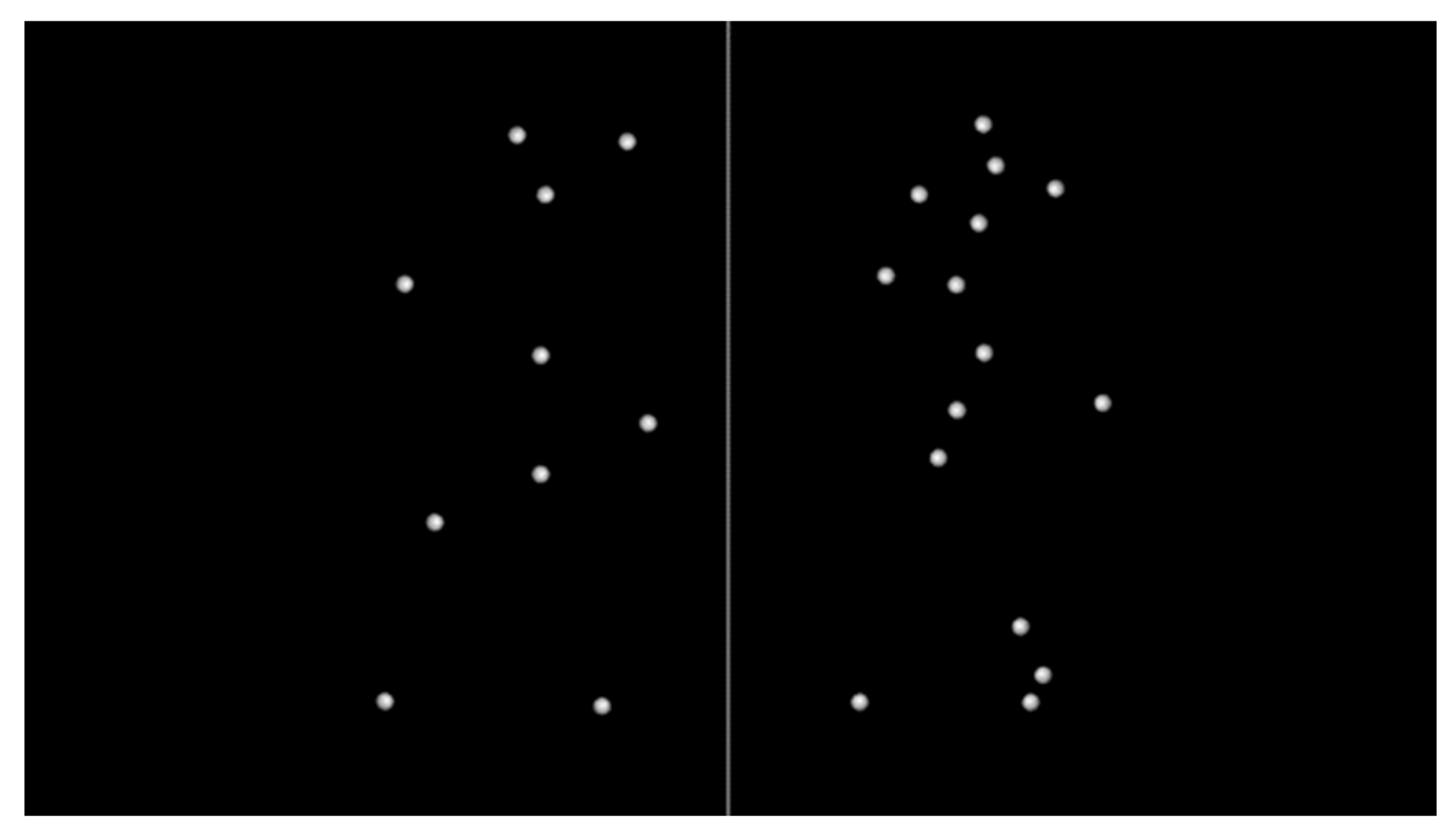
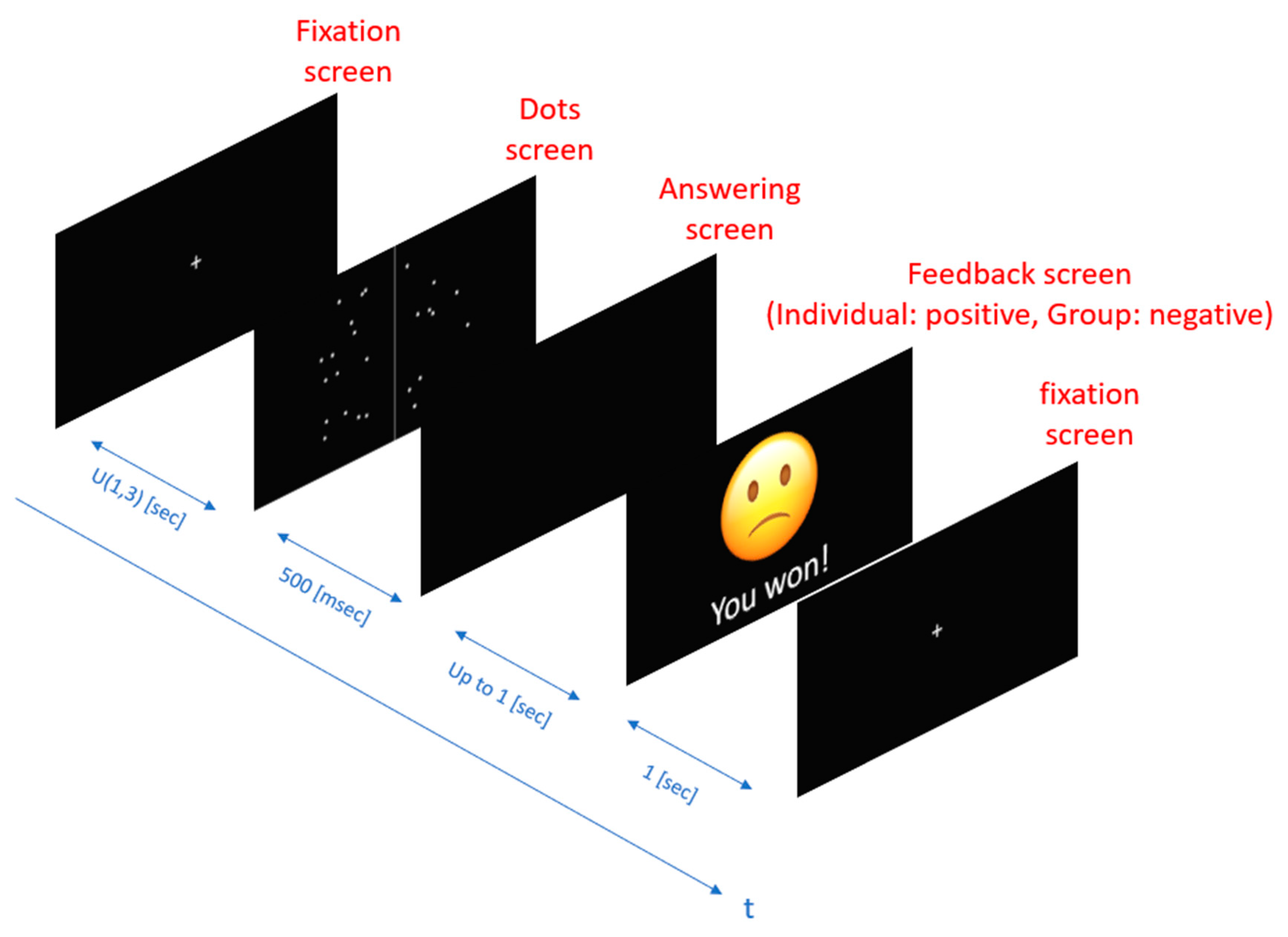
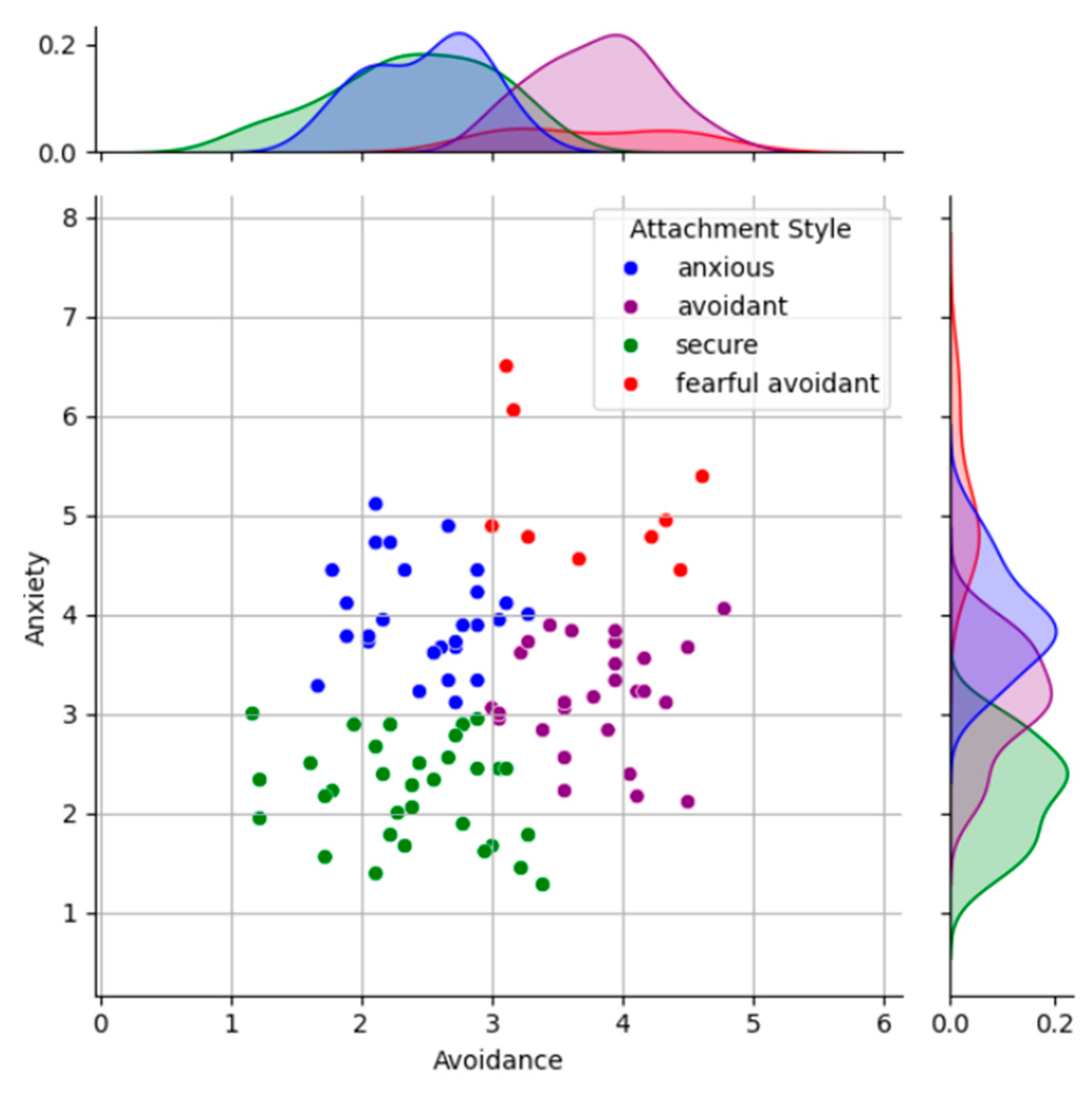
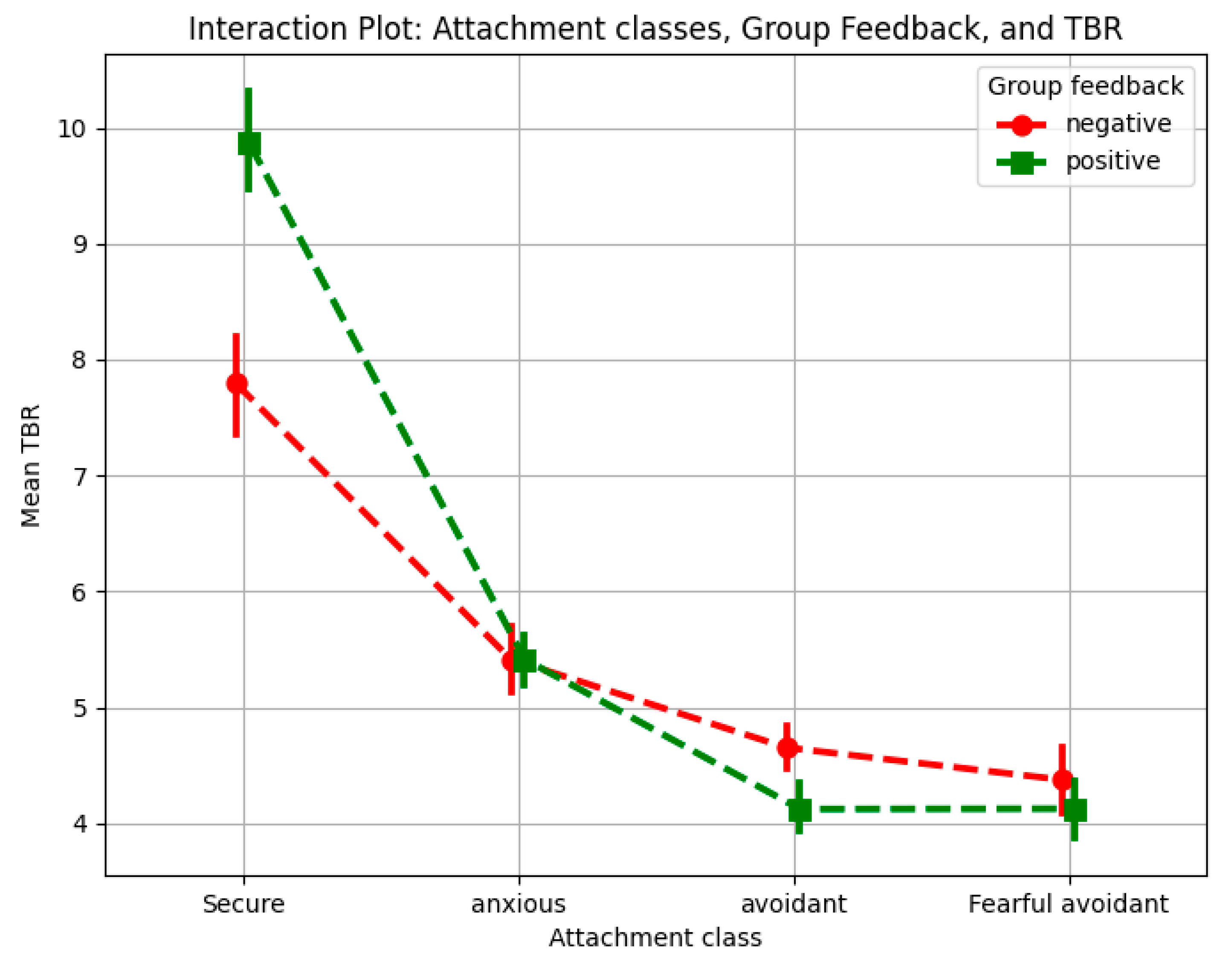


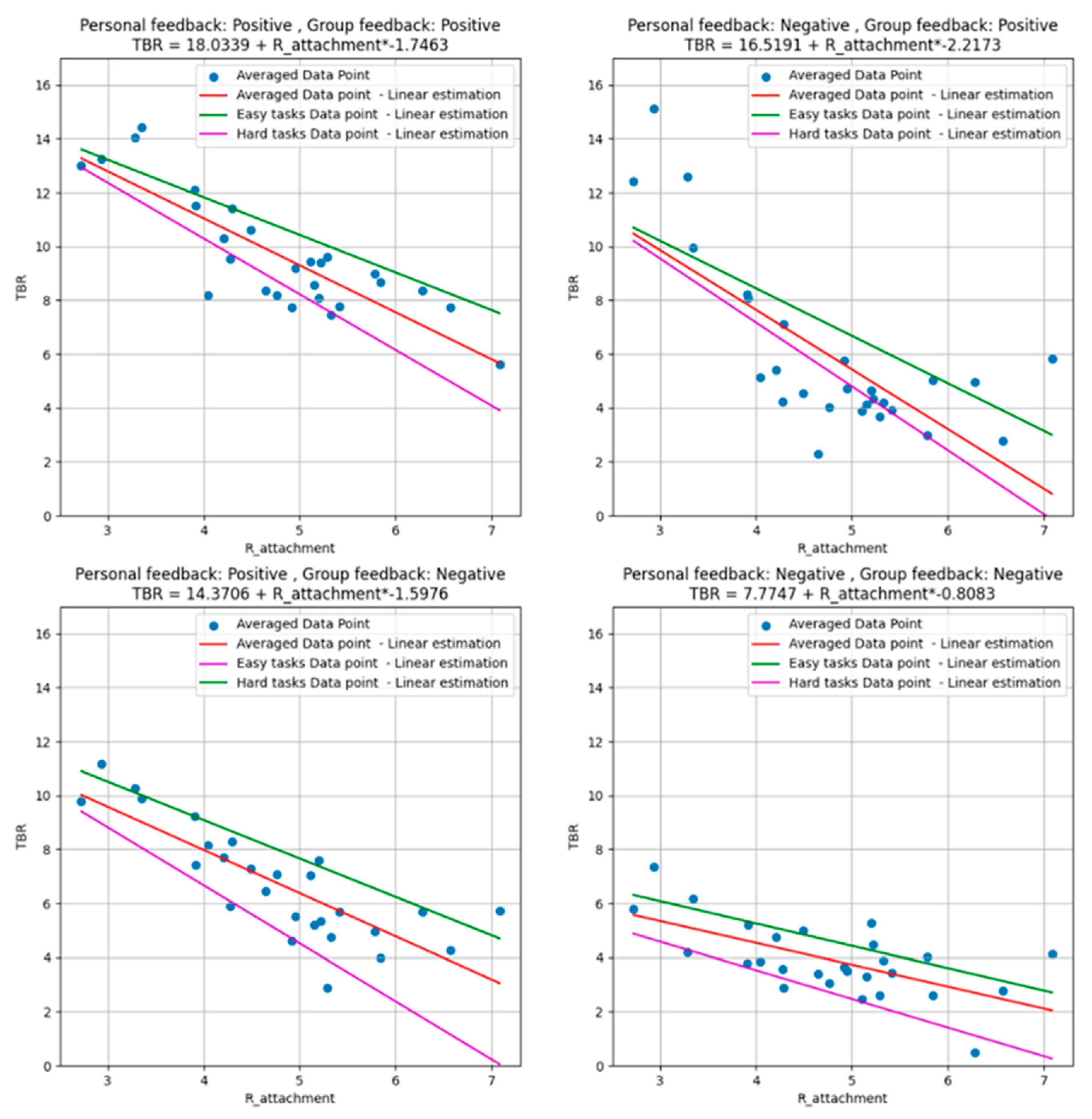
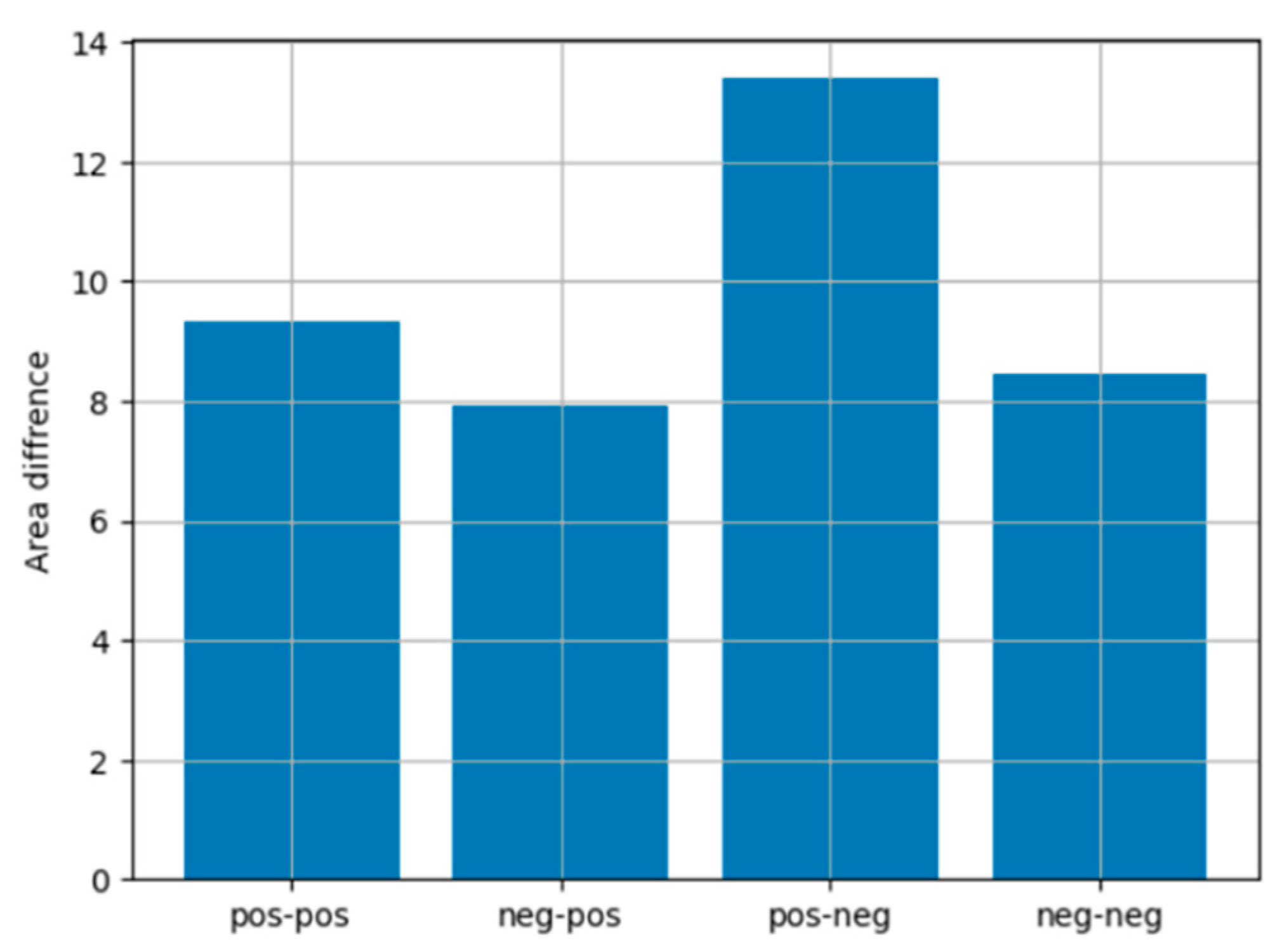
Disclaimer/Publisher’s Note: The statements, opinions and data contained in all publications are solely those of the individual author(s) and contributor(s) and not of MDPI and/or the editor(s). MDPI and/or the editor(s) disclaim responsibility for any injury to people or property resulting from any ideas, methods, instructions or products referred to in the content. |
© 2025 by the authors. Licensee MDPI, Basel, Switzerland. This article is an open access article distributed under the terms and conditions of the Creative Commons Attribution (CC BY) license (https://creativecommons.org/licenses/by/4.0/).
Share and Cite
Mizrahi, D.; Laufer, I.; Zuckerman, I. Attachment Style, Task Difficulty, and Feedback Type: Effects on Cognitive Load. Behav. Sci. 2025, 15, 427. https://doi.org/10.3390/bs15040427
Mizrahi D, Laufer I, Zuckerman I. Attachment Style, Task Difficulty, and Feedback Type: Effects on Cognitive Load. Behavioral Sciences. 2025; 15(4):427. https://doi.org/10.3390/bs15040427
Chicago/Turabian StyleMizrahi, Dor, Ilan Laufer, and Inon Zuckerman. 2025. "Attachment Style, Task Difficulty, and Feedback Type: Effects on Cognitive Load" Behavioral Sciences 15, no. 4: 427. https://doi.org/10.3390/bs15040427
APA StyleMizrahi, D., Laufer, I., & Zuckerman, I. (2025). Attachment Style, Task Difficulty, and Feedback Type: Effects on Cognitive Load. Behavioral Sciences, 15(4), 427. https://doi.org/10.3390/bs15040427






